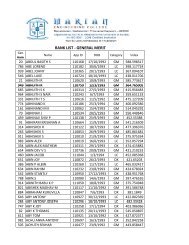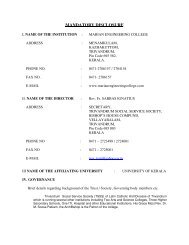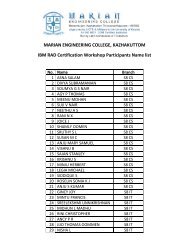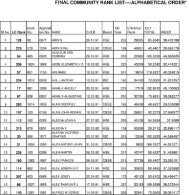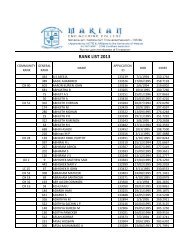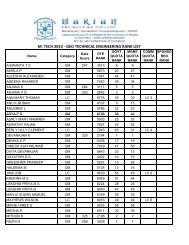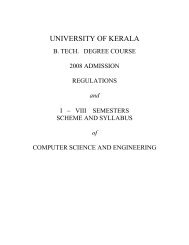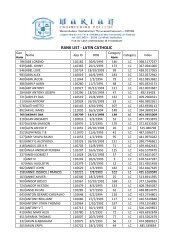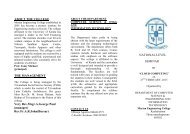UNIVERSITY OF KERALA - College of Engineering, Trivandrum
UNIVERSITY OF KERALA - College of Engineering, Trivandrum
UNIVERSITY OF KERALA - College of Engineering, Trivandrum
Create successful ePaper yourself
Turn your PDF publications into a flip-book with our unique Google optimized e-Paper software.
08.806.13. Elective V. SYSTEMS ENGINEERING<br />
FOR CIVIL ENGINEERS<br />
L T P/D Cr<br />
3 0 0 3<br />
Module I<br />
Systems engineering- System-definition and examples <strong>of</strong> civil engineering systems, system analysis, system<br />
design and system synthesis. Steps in analysis <strong>of</strong> systems- Mathematical modeling <strong>of</strong> systems- Optimization<br />
problems-Objective function and constraints.<br />
Formulation <strong>of</strong> the following optimization problems for civil engineers-minimum weight design <strong>of</strong> trusses and<br />
frames, minimum cost design <strong>of</strong> beams, Column design based on Euler’s theory <strong>of</strong> buckling load, Optimal<br />
design <strong>of</strong> water distribution systems, single reservoir operation, Minimum cost design <strong>of</strong> lined irrigation canals.<br />
Traffic signal time optimization, Effluent disposal to rivers.<br />
Concavity and convexity <strong>of</strong> optimization problems- Solution <strong>of</strong> single variable optimization problems-Calculus<br />
based methods, Newton, bisection and secant method<br />
Module- II<br />
Solution <strong>of</strong> multi variable optimization problems- Lagrange multiplier method-KKT conditions. Unconstrained<br />
optimization techniques for multi variable problems-direct search methods, Random search, uni-variate and<br />
pattern search-Hook and Jeeve’s method, Descent methods-Fletcher and reeves method, Quasi-Newton methods<br />
(conceptual idea only),<br />
Constrained optimization and constraint handling - penalty function approach (conceptual idea only).<br />
Module- III<br />
Dynamic programming (DP) - Bellman’s principle <strong>of</strong> optimality, Application <strong>of</strong> DP to a pipe network problem.<br />
Basic ideas <strong>of</strong> integer programming and multi-objective optimization (Descriptions only).<br />
Evolutionary algorithms for optimization- Basic principles <strong>of</strong> Genetic Algorithms, Simulated Annealing and<br />
Swarm Intelligence Techniques (Ant colony optimization and particle swarm optimization) (conceptual ideas<br />
only).<br />
Simulation-Concept <strong>of</strong> Monte Carlo Simulation (No numerical problem).<br />
References/ Text Books<br />
1. Fox R L -Optimization methods for engineering design – Weily<br />
2. Rao S S -<strong>Engineering</strong> Optimization-theory and practice-, New Age International<br />
3. Belegundu and Chandrapatla-Optimization concepts and applications in engineering-, Prentice Hall<br />
India Ltd<br />
4. Deb K -Optimization for engineering design- Algorithms and Examples–, Prentice Hall India Ltd<br />
5. Haftka R T and Gurdal Z -Elements <strong>of</strong> structural optimization-Springer<br />
6. Goldberg DE-Genetic Algorithms in search, optimization and machine learning.<br />
7. Engelbrecht A P -Fundamentals <strong>of</strong> computational swarm Intelligence- Weily<br />
8. Kennedy J and Eberhart R C-Swarm Intelligence- Morgan Kaufaman<br />
9. Arora J S-Introduction to optimum design- Elsevier<br />
10. Vedula P and Mujumdar P P-Water resources systems- TMH<br />
Question paper: Duration: 3 Hrs<br />
The question paper consists <strong>of</strong> part A and part B.<br />
Part A consist <strong>of</strong> 8 questions <strong>of</strong> 5 marks each. Candidate has to answer all questions.<br />
Part B is for 60 marks. Part B is divided into three modules. Candidate has to answer one full question out<br />
<strong>of</strong> two, from each module.<br />
Note: At least one assignment should be computer oriented. The candidate should practice to solve simple<br />
optimization problems from civil engineering field using any commercial s<strong>of</strong>tware.<br />
119



